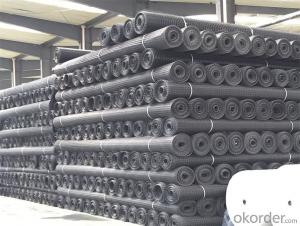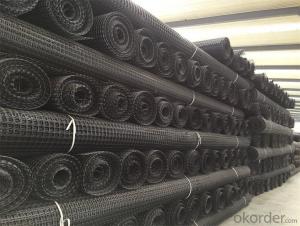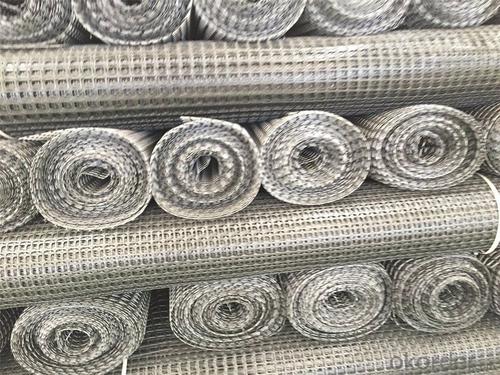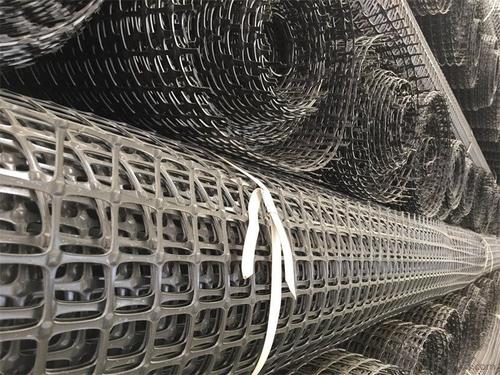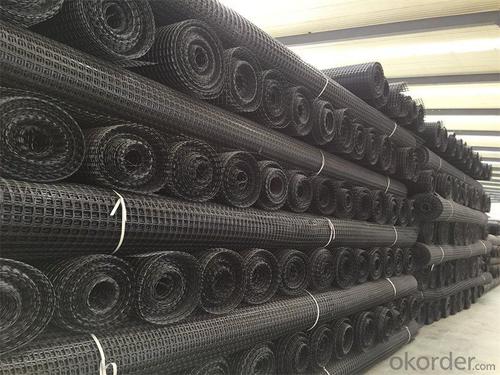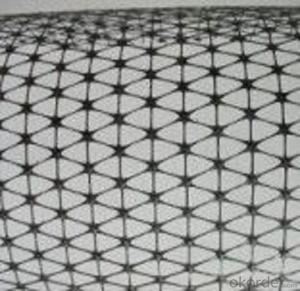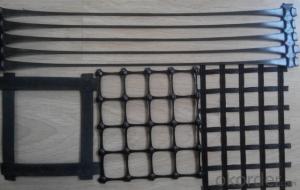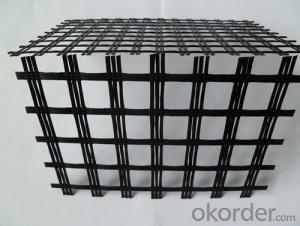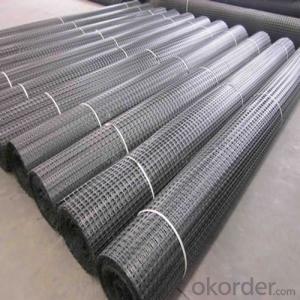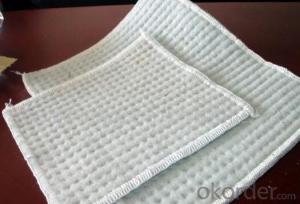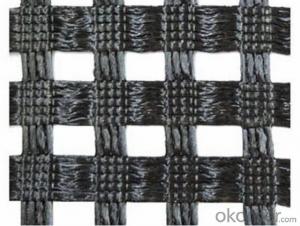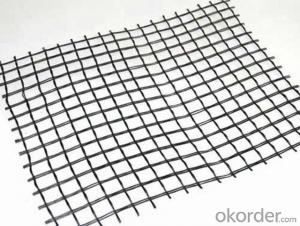Geogrids for Access Routes:Lightweight Grass Protection for Civil Engineering Construction
- Loading Port:
- China main port
- Payment Terms:
- TT OR LC
- Min Order Qty:
- 1000 m²
- Supply Capability:
- 1000000 m²/month
OKorder Service Pledge
OKorder Financial Service
You Might Also Like
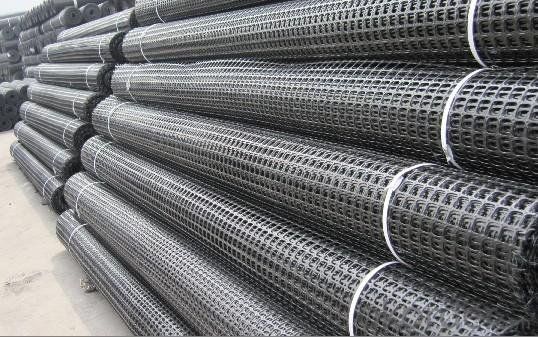
Introduction
The geogrid elements vary in polymer type and cross-sectional dimensions. They can sometimes change shape and dimensions within their length. Geogrids are either integrally manufactured (punched and drawn sheets; or extruded), ultrasonically or adhesive bonded strips, or joined in a knitting or weaving process and then coated. Polymer types include polyethylene, polypropylene or high tenacity polyester that has been coated.
Although geogrids are used primarily for reinforcement, some products are designed for asphalt overlay and waterproofing or for separation and stabilization. Geogrids also are used as gabions and sheet anchors, inserted between geotextiles and geomembranes, or used to construct mattresses for fills or embankments over soft soils.
WEIGHT
300G/SQM
500G/SQM
ELONGATION AT BREAK
3%
TENSILE STRENGTH IN KNOT
5KN/M
10KN/M
WIDTH:
1--6M
Our Service
Quality assurance
1.On a regular basis or as per your request,we entrust national testing agencies to conduct quality inspections
2. Strictly in accordance with the ISO9001-2008 international quality system standard,we monitor and manage the whole process throughout production,quality testing,and measurement to ensure product quality
3. For quality-related construction delay or substandard construction(except for damage or losses due to customer’s responsibility or irresistible natural disasters),we have refunding,replacement,and repair services.We will respond to customers’ feedbacks on quality issues within 24 hours.
Packaging & Shipping
Packing: PLASTIC FILM INSIDE, AND WOVEN BAG OUTSIDE
Shipping: About 15 days after receipt the deposit
FAQ:
Q: What kind of payments does jenor support?
A: T/T, L/C, Cash are accepted.
Q: Do you charge for the samples?
A: Accordeing to our company policy, the samples are free, we only charge the freight fee. And we will return the freight fee during the next order.
Q: Can you produce according to customers' design?
A: Sure, we are professional manufacturer, OEM and ODM are both welcome.
Q: Do you have other products?
A: Yes, please check the pictures:
- Q: Can geogrids be used in shoreline erosion control projects?
- Yes, geogrids can be used in shoreline erosion control projects. Geogrids are often used to stabilize and reinforce soil in coastal areas to prevent erosion and maintain the integrity of shorelines. They can be installed to reinforce slopes, prevent soil movement, and provide structural stability to prevent further erosion.
- Q: What are the factors that affect the long-term oxidation resistance of geogrids?
- The factors that affect the long-term oxidation resistance of geogrids include the type and quality of polymer used in the geogrid manufacturing, the presence of antioxidants or stabilizers in the polymer, exposure to environmental conditions such as temperature, humidity, and UV radiation, as well as the level of mechanical stress or strain experienced by the geogrid over time.
- Q: What are the benefits of using geogrids in pavement construction?
- Geogrids offer numerous benefits in pavement construction, including enhanced stability and strength, improved load distribution, reduced cracking and rutting, increased lifespan of the pavement, and decreased maintenance requirements. Additionally, geogrids can help control and prevent the migration of aggregate particles, leading to a more durable and long-lasting pavement structure.
- Q: Can geogrids be used in retaining wall drainage systems?
- Yes, geogrids can be used in retaining wall drainage systems. Geogrids are commonly used to provide additional stability and reinforcement to retaining walls. They help to distribute the load and prevent soil erosion behind the wall. Additionally, geogrids can enhance the drainage system by allowing water to flow through them, preventing the buildup of hydrostatic pressure behind the wall. This helps to maintain the structural integrity of the retaining wall and prevent any potential damage.
- Q: Are geogrids suitable for reinforcing landfill liners?
- Yes, geogrids are suitable for reinforcing landfill liners. They are commonly used in landfill engineering to enhance the stability and strength of liners by reducing deformation and improving load distribution. Geogrids also help to prevent soil erosion and provide long-term reinforcement, making them an effective solution for reinforcing landfill liners.
- Q: What are the differences between geogrids and geocells?
- Geogrids and geocells are both materials used for soil reinforcement and stabilization, but they have distinct differences. Geogrids are typically made of high-strength synthetic materials such as polyester or polypropylene, and they are formed into a grid-like structure. They provide tensile strength to soil, preventing lateral movement and improving load distribution. On the other hand, geocells are three-dimensional cellular structures made from materials like high-density polyethylene. They create a honeycomb-like network that confines soil particles, preventing erosion and promoting load-bearing capacity. While geogrids are commonly used for soil stabilization in applications like road construction, geocells are often employed for erosion control and slope stabilization.
- Q: How is the strength of a geogrid determined?
- The strength of a geogrid is determined through various testing methods such as tensile strength testing, pullout testing, and creep testing. These tests evaluate the geogrid's ability to resist deformation, withstand loads, and maintain its structural integrity over time.
- Q: Are geogrids suitable for use in reinforced embankments?
- Yes, geogrids are suitable for use in reinforced embankments. Geogrids provide soil stabilization and enhance the strength of the embankment by distributing loads and reducing lateral movement. They have been widely used in various civil engineering projects for reinforcing slopes and retaining walls, making them a reliable and effective solution for reinforced embankments.
- Q: Engineering effect of steel plastic geogrid
- 1, high strength, small creep, adapt to all kinds of soil environment, can fully meet the use of high grade highway retaining wall.2, can effectively improve the reinforced bearing surface, occlusal function, interlocking greatly improve foundation bearing capacity, effectively restrain the soil lateral displacement of reinforced foundation, stable performance.3, compared with the traditional grid has greater strength, strong bearing capacity, corrosion resistance, anti-aging, friction coefficient, perforated uniform, convenient construction, long service life and other characteristics.
- Q: Overview of fiberglass grille
- With the warp and weft two-way high tensile strength and low elongation, and high temperature resistance, low temperature, aging resistance, corrosion resistance and other excellent properties, is widely used in the asphalt pavement, cement concrete pavement and subgrade reinforcement and railway roadbed, dam slope, airport runway, anti sand control project.
Send your message to us
Geogrids for Access Routes:Lightweight Grass Protection for Civil Engineering Construction
- Loading Port:
- China main port
- Payment Terms:
- TT OR LC
- Min Order Qty:
- 1000 m²
- Supply Capability:
- 1000000 m²/month
OKorder Service Pledge
OKorder Financial Service
Similar products
Hot products
Hot Searches
Related keywords
